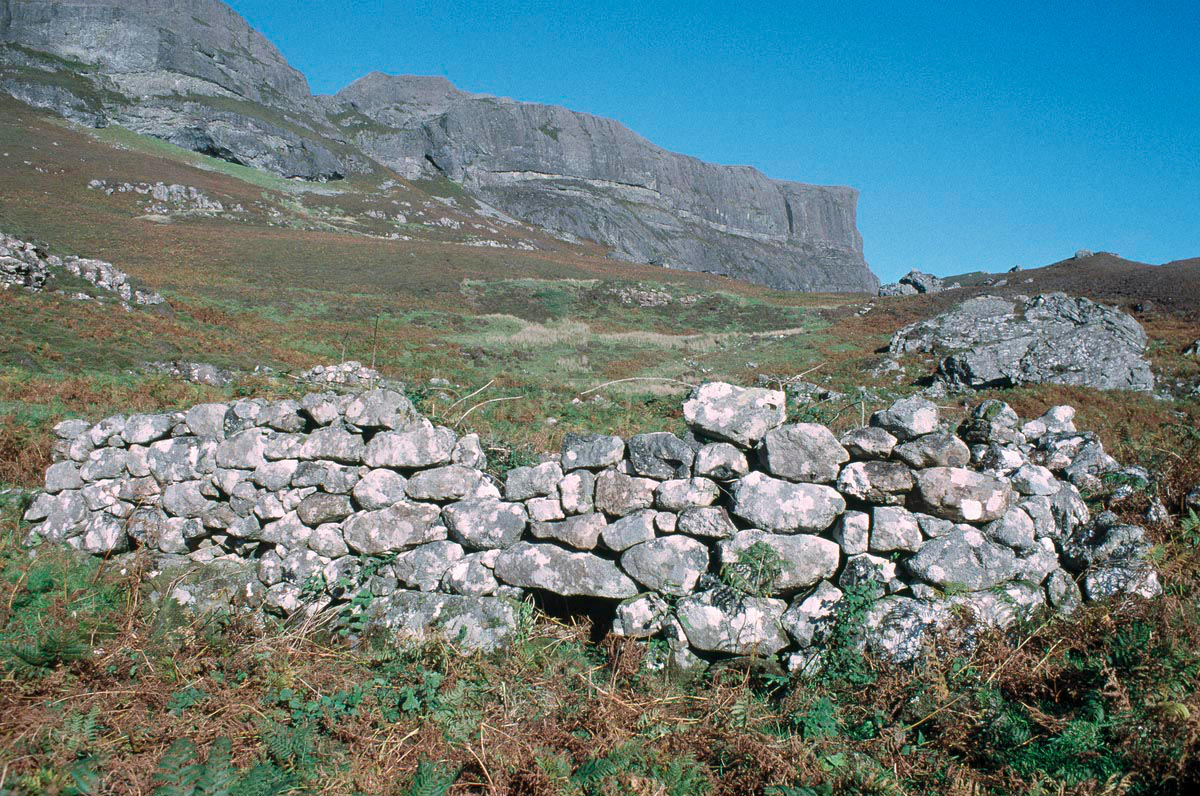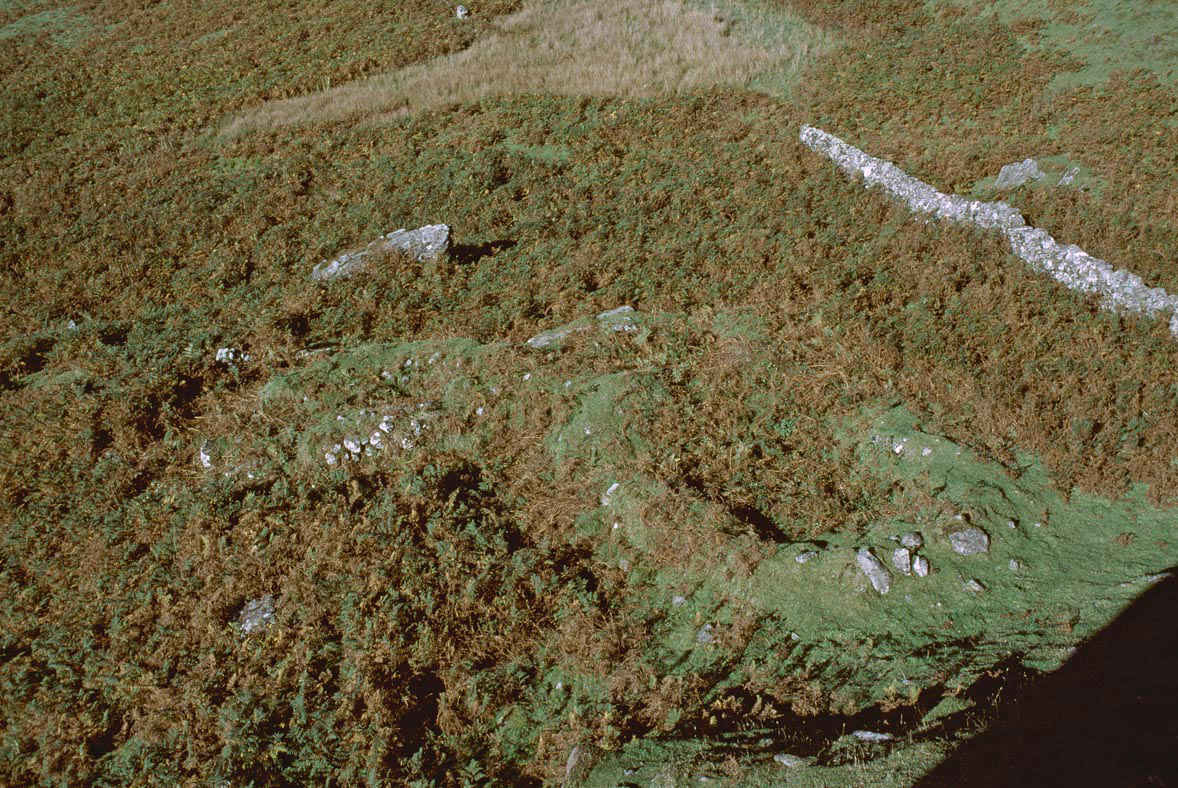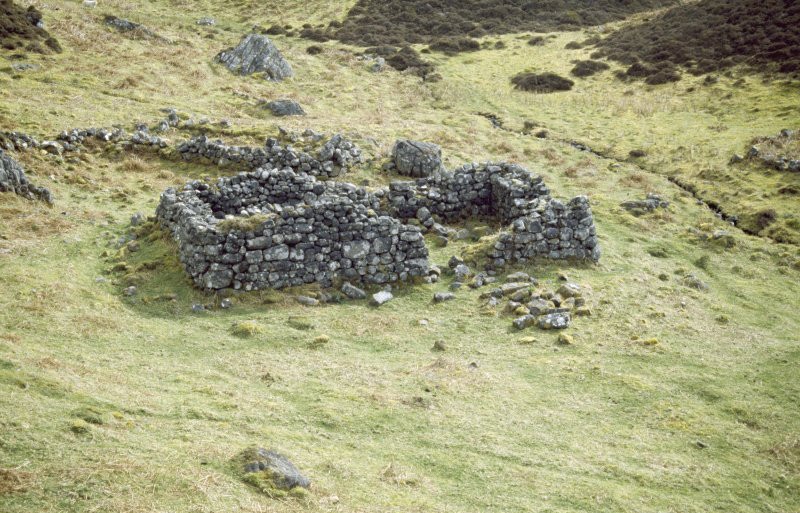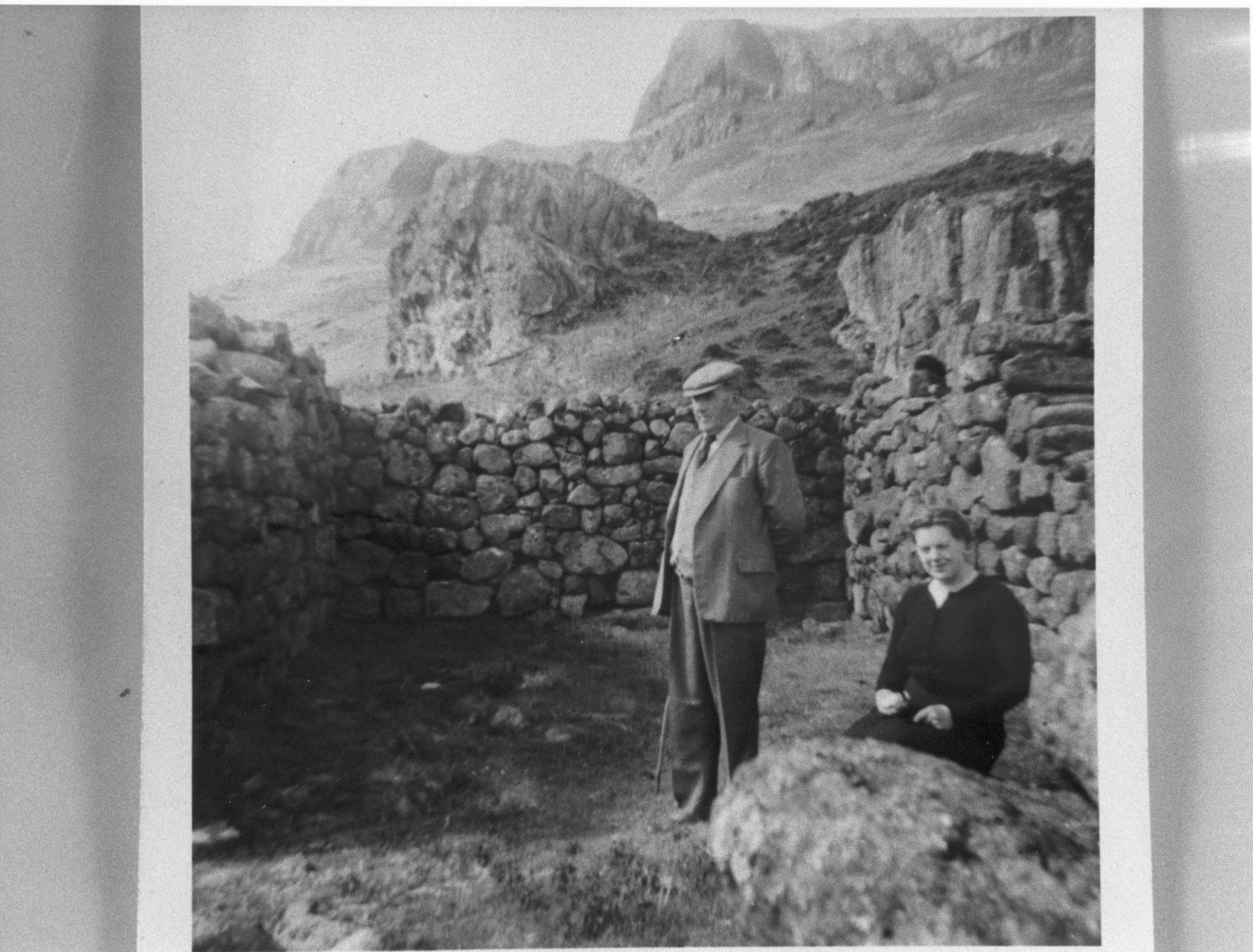The township of Upper Grulin (meaning "stony place" after a legend that the giants Husdal and Nuallan battled here, littering the ground with rocks in their struggle) sits amongst impressive boulders beneath the island's famous Sgurr.
The township is situated on sloping ground above sea-cliffs, and surrounded by an extensive and well-preserved system of irregular fields, enclosed by substantial turf and stone dykes within which there are fragments of rig cultivation.
There are the remains of at least 42 buildings, including those of a kiln barn, a corn-drying kiln, three huts, and several enclosures. Most are built of stone, with rubble cores faced inside and out, although at least five are turf-cored of the type seen in Five Pennies or Braighe.


There is also an Iron Age dun occupying a rocky hillock to the SW edge of the township. It is much older than the township, but sits on the same terrace, separated by the remains of a rough rubble wall. Inside the dun there are at least three circular house platforms. However, there is also a later structure built using stone robbed from the fort, which is possibly associated with the township.

A well is situated on the SW extremity of the township. Known locally as the Well of the Holy Women, it is built of drystone rubble and measures about 1m square. It would have provided the township with a plentiful water supply for both occupants and animals, and may also have been a place to receive blessings and to drink holy water.

There is evidence in the landscape of a number of agricultural activities happening at Grulin.
There are shieling huts further north towards the base of the Sgurr, and these are likely to have been associated with the township. Shieling huts were seasonal structures inhabited by women and children from the community during the summer months, when they would take their animals up into higher pastures for grazing.
We can say with some certainty that these are shieling huts for a number of reasons. Firstly, their size. They are much smaller than the other buildings, suggesting that they were designed to hold only a few occupants temporarily – for instance, over the summer months.
Secondly, their position in the landscape; the huts sit high on the hill near areas of good grazing, away from the township, but within the territory of farms recorded on post-medieval maps of the area. hence, it seems reasonable to assume that they are associated with the township's occupants.
It is possible to identify other agricultural buildings at Grulin, such as byres.
We can see that there is a hole in the wall of this building. As it is too small to be a doorway, it is likely that this is a drain. Byres always have drains similar to this one, to ensure that all animal waste from the byre can flow out and away from the dwelling it is associated with. Hence, it is possible that these buildings are houses with accompanying byres in which to house their animals.

Lastly, we can also identify a corn-drying kiln to the NW of the township.
This distinct hollow would have been used to dry cereals, indicating that a variety of crops were also being grown around the area.


Several clues can help suggest a date for the settlement between the 18th and mid-19th centuries, including the condition of the buildings, the architecture, and additional features.
Firstly, they are not as extensively ruined as settlements elsewhere on the island, suggesting that they were constructed at a later date, or at least were occupied longer than other settlements. Secondly, the majority of the buildings are rubble-cored rather than turf - unlike at Five Pennies or Braighe - with rounded external corners and square internal ones, and most feature doorways and other additions. This more sophisticated architecture also points to a more recent date. It is likely too that even those turf-core buildings that are apparently older may have continued in use until the settlement's abandonment.

Much like at Five Pennies, the structures may have been roofed using thatch and a timber frame – use the slider below to see how a Grulin house would have looked prior to its ruin.

© Gargunnock Estate Trust

Due to Grulin's size and its occupation until recently, there is actually quite a bit of recorded history for the township. The 1841 census shows all of the families living in Upper Grulin to be crofters or herdsmen, indicating an entirely agriculturally-based economy; the remains of the buildings there -the byre-houses, shieling huts, corn kiln, and barn -seem to attest to this too.

© Isle of Eigg History Society
Upper Grulin's sad demise was related in Tocher in 1971 by Hugh Mackinnon, the last remaining member of an Eigg family going back many generations. His grandfather's family was one of only two Grulin families who remained on Eigg when the township was cleared in 1853 to make room for sheep farming - the rest of the township's population set sail for Nova Scotia, never to return.
The Clearance of Gruline – Hugh MacKinnon
HM: Anyway, I told you the story about when Angus Laig went to America, and his mother and cousin went too, at eighty years of age. And anyway, the laird was looking for a new farmer to take care of Laig and Grulin, that's on the south east side of the Laig moor. There was a farmer in Laig at that time as well. And there were fourteen families in Grulin at the time, and the area was divided into Lower Grulin and Upper Grulin, that's what we called it. There are seven families in each place, that's fourteen families altogether. And the way I heard it, the man who was going to evict them from the land...anyway, my grandfather was one of the people who was there and he and his brother had an area of pennyland which they looked after between them. And as my mother said, they had livestock on the pennyland. (And my own grandfather said that there were 5 cows and one person x x pennyland). But anyway, the lowland farmer came to look at the land in Laig and he said to the laird, Doctor MacPherson, 'Oh indeed, I will give you a far higher rent than MacDonald is paying.' And he said, 'There's one condition, I want you to evict the crofters in Grulin. I want the land for my sheep.' An our laird was like so many others in the Highlands at the time, all he had to do was tell the poor crofters in Grulin that they had to leave and that they would be evicted from the land at Whitsun, in the year 1853, and that they would have to go to America. And there were two families out of the fourteen who lived between the two Grulins who stayed, and my grandfather was one of them. And his name was Donald, son of Iain, he was a MacLellean. And the reason that my grandfather stayed when the others left was because of his father in law, Neil MacQuarrie, son of Lachlan they called him, he had a croft and a house over in Cleadale and instead of seeing his daughter, who was married to my grandfather, her name was Sarah, instead of seeing her go to America, he said to my grandfather that he had another croft in Cleadale, in addition to the one that he looked after, and that he was welcome to come and live in the croft. My grandfather came down to the croft in 1853 from Grulin and I stay in the same croft to this day. And anyway, the poor people were evicted and left for America. I'm not sure but I think they went to Nova Scotia or somewhere like that anyway. But we lost touch with all of them, I don't think that any of the people that left ever got in touch with anyone to let them know how they were getting on. Anyway, Grulin was settled by sheep after this and and it was my grandfather, Hector MacQuarrie, who was there. He was Angus Laig's shepherd before he left and he stayed with the Stewart for a year or two after he arrived. And the next year, after Angus Laig, he left Grulin, that's a year after he left, and the Stewart settled Grulin with sheep. There wasn't a sheep in Grulin that didn't have twin lambs. The land was so rich and fertile after being cultivated and improved by the poor people who left for America when the sheep were put it. There wasn't a lamb born that didn't have a twin. Yes. That's what I heard them say. And I don't now how many years the man, Grant Stewart, stayed in Laig.
DM: Where did the Stewart come from?
HM: He came from the Borders, I'm not sure if he was from Dumfries or somewhere else in the Borders.

